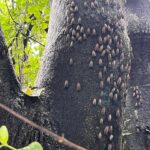You may have seen viral TikTok videos where swarms of lanternflies have nestled themselves all over New York City. TikTok user @cashay shows people unable to leave their homes because the pesky insects have descended upon a building’s entrance. A similar situation has occurred here in Canarsie, except these homeowners have no viral video to showcase the swarms of lanternflies which have taken over their building’s parking lot.
Ms. Jones, a property owner at Ocean Rock Condos, located on Rockaway Parkway and Schenck Street, reached out to the Canarsie Courier when it seemed like she was not making any progress with the city or state government in removing the lanternflies that have infested the trees, belonging to the city, in the parking lot behind her building. Jones and other condo owners noticed the lanternflies living off trees and plants at their location about a year ago. The lanternflies would excrete a sticky liquid onto cars, and homeowners were forced to wash their cars at least twice a week. This sticky liquid is their eggs; each lanternfly can lay up to 30 to 50 eggs. According to the NYS Department of Environmental Conservation (DEC), lanternflies are from Asia and mainly feed on a variety of plants and trees such as heaven trees, grapevines, hops, maples, walnuts and fruit trees.
The government website states that these insects were first found in the United States via Pennsylvania in 2014 and then in Staten Island in 2020. However, there is no specific information about when they arrived in Brooklyn. Lanternflies have taken over the parking lots of Ocean Rock Condos to the extent homeowners now park on the street. Jones reached out to the offices of Councilwoman Mercedes Narcisse, Congressman Hakeem Jeffries and State Senator Roxanne Persaud. All local and state leaders share a website created by the NYS Department of Agriculture (NYDA) to track lanternfly complaints. While all state and local leadership were helpful in directing her to the correct department, Jones reached out to the Department in June and has not received any response.
The DEC website states that lanternflies are harmless to humans but can cause major damage to our agriculture and ecosystem. The nymphs or newly hatched spotted lanternflies are black with spots; you’ll see those before they become adults. The full black lanternflies can be seen in April to July, and the red ones from July to September. The adult lanternflies lay egg masses on almost anything – tree trunks, rocks, cars, even firewood. The sticky liquid Jones and other condo owners see on their cars are the eggs; the state’s website says the eggs come out in a waxy brownish-gray coating when first laid.
Condo owners are not permitted to cut down the trees where the lanternflies live, as these trees are city property. The owners are hoping the trees can be cleaned to end the infestation or at least cut down to prevent the lanternflies from falling onto their cars in the lot. Jones called 311 over a month ago, and they promised to send someone to assess the trees, but there has been no follow-up or action taken. Adrian, the treasurer of Ocean Rock, says the lanternflies have even been found in condo owners’ homes. He’s concerned about the use of street parking, as it takes away parking availability from others in the community.
The Canarsie Courier spoke with NYDA Plant Industry Director Chris Logue, who provided some key information about lanternflies that all residents should know. Currently, lanternflies are only found on the East Coast. States like New York and Pennsylvania are primarily being affected by the lanternflies. There is a five-year plan to get the lanternfly population under control. Right now, the Department of Agriculture in these states is working with scientists and brilliant minds from places like Cornell and Temple University, as well as the USDA, to create a plan to stop the lanternflies from destroying the states’ grapes. Lanternflies have started to eat at both states’ grape production, which can affect our wine production and fruit industry overall. Logue asks residents to check their cars for any lanternfly eggs before heading out to Suffolk County wineries. The lanternflies can hitch a ride on cars and flat surfaces and then start breeding when they get to their new destination. Even though NYC residents are encouraged to document where they are finding the lanternflies, that is not necessary now.
Logue recommends working with local city officials on a removal process. One way to remove clusters of lanternflies, like the ones on the trees at Ocean Rock, is to vacuum them off the tree. This is called egg scraping; now is the best time to egg scrape because lanternflies go into hibernation during the fall and winter months. Logue says it will feel like a daunting task, but after a few runs with the vacuum, you’ll start to see them decrease and finally removed from the tree. The trees can be sprayed with a solution, but Logue recommends speaking with a professional first.
He also reminds residents that lanternflies are harmless to humans. They understand people’s frustration, and they are working hard to control the situation. The DEC provides tips on identifying infestations and how to address them; outside of these tips, they also say if you see a lanternfly, stop them; that’s the fastest way to kill them: (https://www.dec.ny.gov/animals/113303.html)
Some signs of infestation according to the DEC website: “Seep oozing or weeping from tiny open wounds on tree trunks, appearing wet and sometimes emitting fermented odors. One-inch-long egg masses that are brownish-gray, waxy and mud-like when new; old egg masses are brown and scaly. Lanternflies excrete liquid waste called honeydew that accumulates under plants, potentially encouraging the growth of black sooty mold.”
Tips on how to get rid of lanternflies include “Inspect outdoor items like firewood, vehicles and furniture for egg masses. If visiting other states with lanternflies, check all equipment and gear before leaving; remove any egg masses. Destroy egg masses by scraping them into a bucket of hot, soapy water or a baggie/jar of hand sanitizer.”
For more information, visit https://www.dec.ny.gov/docs/lands_forests_pdf/slfposter2.pdf



